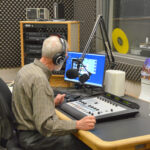Turning back clocks is essential for safety of kids
Daylight saving time was started during World War I to help conserve energy and supplies for the war effort. But I have a different perspective on daylight saving time on why it is beneficial.
I live in rural Jones County, and all through grade school and high school I rode the school bus which meant I was on the school bus by 7:10 a.m. In the fall and winter months before daylight saving time would take effect it would be dark.
It can be very unsafe for children to be getting on the school bus in the dark.
When I was six or seven a quarry was built near my house and the rock trucks would fly past our house very early in the morning and couple of times, they came very close to rear ending my bus while my brother and I were getting on.
From my perspective it is a safety issue for children to be getting on a school bus when it’s dark which is what would happen if we did not observe daylight saving time.
Daylight saving time does not reduce how much sunlight we receive It just dictates what time the clock says it is when we see the sun.
I will also not deny that I find daylight saving time frustrating when I get confused about what time it is and what time it was to be somewhere the first week after it’s taken effect.
But ultimately, I think children’s safety should be paramount. I do not want a child to be hit on the road because someone didn’t see them when it’s dark while they were waiting for their school bus in the morning.

Jessica is in the Digital Arts program and previously graduated with an AA in Liberal Arts and a Bakery Certificate. She enjoys cooking, hiking with her dog, Daisy, taking pictures and spending time with her family.
Adjusting clocks creates added health issues
Daylight saving time was created during World War I in order to conserve candles and coal for the war effort. Because of regular use of electric devices, such as smartphones, televisions and air conditioning, people still use a lot of power regardless of how long the sun is out and in some cases can raise energy consumption.
The number of car accidents increases on the days where the clocks are set back and moved forward. This is because changing the time disrupts the body’s internal clock and the sudden shift in the internal clock creates a loss of sleep.
Aside from a lower amount of alertness, the lack of sleep can also be tied to higher blood pressure, headaches and impaired memory. There are also links to a greater risk of heart attacks or other kinds of heart failure, an increase of miscarriages and more workplace accidents.
Readjusting to change can take anywhere from weeks or even months until the cycle restarts when the clocks are reset.
The shorter evenings during the fall and winter can bring about Seasonal Affective Disorder or SAD. Seasonal Affective Disorder is a condition that is similar to depression but manifests during points of time when people receive a limited exposure to sunlight. Setting the clocks back an hour, prevents people with such a condition from getting the natural light they need.
This is why daylight saving time does more harm than good. We have surpassed the need for the clocks to reset every spring and fall.
Categories: Opinion, Point-Counterpoint










